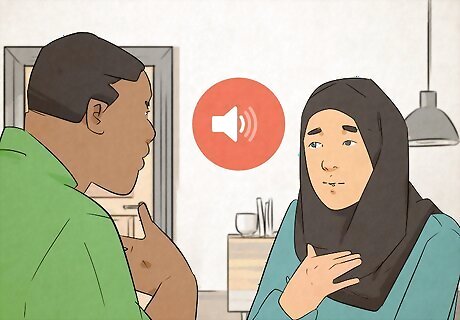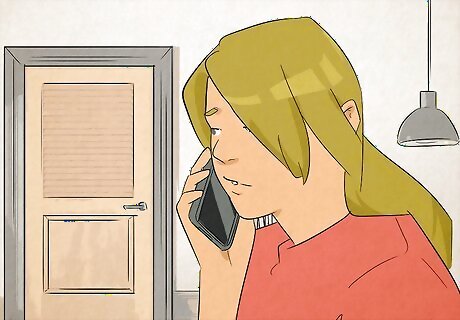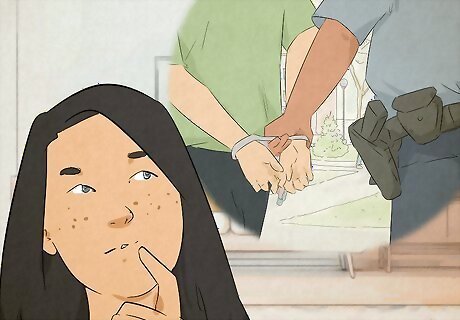
views
- Defuse the situation by speaking in a low voice, using non-threatening body language, and empathizing with the violent person’s emotions.
- Try not to deal with a violent person alone. Trust your gut if you sense danger and always keep an eye on the exit in case things get out of hand.
- Look for red flags like drug or alcohol abuse, a history of violence, or a sudden change in a person’s life like a breakup or getting fired.
Defusing Anger

Stay calm. Take a deep breath. Don’t take the other person’s anger personally. Instead, focus on keeping an emotional distance from them. Keep that intention in mind as this person acts out in anger. Avoid becoming agitated, raising your voice, or fighting with the person. Instead, actively think about skills you can use to help the other person regulate the situation enough to have a balanced conversation. Remember that anger is always rooted in someone’s pain. It’s not about you, even if the person is taking out their feelings on you. You are not responsible for diffusing their anger. If they are not willing to work toward calm, disengage as soon as possible. People tend to mimic the behavior of those around them. Keeping calm may help the other person to slow or stop their anger.

Keep your voice down. Even if the other person is shouting at you, respond to them as calmly as you can. If they are too worked up to communicate rationally, don’t say anything until they quiet down a little. If you raise your voice, you’ll only fuel the person’s anger. Don’t encourage them to fight.

Avoid telling the person to calm down. Saying something like “Settle down” or “Relax” will probably just make the person angrier. They may resent being told what to do and feel like you are brushing off their problem. Create a connection with the person by acknowledging their anger instead. Say something like, “It seems like this is bothering you. Can we talk about it?” or "I want to understand how you feel and I think that would be easier if we could talk instead of yelling." If you are in a public place, ask the person if there is somewhere you can go to work out the issue. If you feel nervous going on your own, ask someone along to act as a moderator and serve as your witness.

Reflect the person’s feelings. When the person tells you what’s wrong, empathize with them. Make them feel like you’re on their side, even if you don’t agree with them. They will be less likely to turn violent if they feel understood. For instance, you might say something like, “So you’re hurt that no one told you about the change of plans ahead of time, is that right? You feel like no one wanted to include you.”

Use non-threatening body language. Maintain an open, relaxed posture. Make eye contact with the angry person, but keep your expression non-confrontational. Don’t make animated gestures, put your hands on your hips, or fold your arms. Move slowly and calmly. Give the angry person plenty of space. This also gives you some protection if they do become violent.
Staying Safe

Trust your gut. Your instincts are often better at recognizing danger than your rational mind is. If something about a situation seems off, or if you don’t have a good feeling about someone, listen to your gut and get to safety as soon as you can. You may feel butterflies in your stomach or hair raising on the back of your neck. Alternatively, you might be hyper-focused or hyper-vigilant when this person is around. It’s always better to be too cautious than to get into a dangerous situation. If you don’t know how to leave a situation, make up an excuse. Say that you have to let your dog out or pick up your friend whose car broke down. If the other person is acting violent or threatening violence, leave as soon as is safe to do so. You don't need to make excuses and stick around. Violence for self-defense, and to make an arrest as a police officer or when the person did something illegal (especially a felony) is justified. However, violence for anything else is never permissible and is considered illegal assault. Plus, you shouldn't have to deal with the latter under any circumstances.

Always have access to an exit. If you’re inside with a potentially violent person, make sure you can get to the door easily. Don’t block the door, though. If the person feels trapped, they may be more dangerous to deal with. Get into the habit of noticing where the exits are everywhere you go.

Avoid dealing with a violent person alone. If possible, ask a colleague, friend, or family member to stay with you when you deal with someone who might turn violent. The presence of someone else might be enough to keep the violent person calm. If they do decide to use physical force, you’ll be safer with backup than without it. For instance, if you are a nurse treating a patient who has a history of violence, it’s a good idea to ask one of your colleagues to step into the room with you.

Learn basic self-defense. Knowing some self-defense moves could save your life if you’re ever attacked. Search the internet for some simple techniques you can practice at home, or sign up for a beginners’ self-defense class. Ask a friend to help you practice the techniques you learn.

Keep children away from the person. If you know that someone with violent tendencies is frequently around children, make their safety your top priority. If they are your kids, take them to stay in a safe place, like a family member’s house. If they are someone else’s, offer to look after them temporarily or help their parent find a place to take them. If you think that any children are in a dangerous or abusive home situation, let the appropriate authorities know immediately. Younger kids can’t protect themselves, so they depend on adults to protect them. Don’t assume someone else will report a bad situation – report it yourself if you know something is wrong.

Have an emergency plan. Know what you will do if someone around you becomes violent. Ideally, you should leave the building and call the police. If you are at home and cannot leave, retreat to a safe room and lock the door before calling emergency services. If you live with a partner or children, come up with an emergency plan together. Make sure everyone understands what to do to stay safe in a crisis.
Recognizing Warning Signs

Consider the person’s history of violence. Previous violence is the biggest predicting factor for whether someone will become violent in the future. Getting into fights, committing violent crimes, being cruel to animals, and breaking things in fits of anger are all examples of violent behavior.

Look for changes in a person’s behavior. If you know the person, be aware of whether their behavior seems different or off in any way. Notice whether they’re acting particularly confrontational, secretive, or irrational. Pay attention to changes in mood as well, such as angry outbursts or expressions of hopelessness. For instance, if the person you’re dating has started yelling at you over minor issues, proceed with caution – anger management problems can often escalate into violence.

Think about whether the person’s circumstances have changed lately. Ask yourself whether the person has recently lost a job, ended a relationship, or subscribed to an extreme belief system. Negative life changes can spur a person towards violent behaviors.

Find out whether the person is using drugs or alcohol. Drugs and alcohol impair a person’s judgment and lower their inhibitions, making them more likely to act on violent urges. If someone you know shows red flags for potential violence and also uses substances frequently, be cautious around them. According to the NCADD, 40% of violent crimes involve alcohol use.

Know how to spot the signs of anger. Someone who is getting angry may look tense and unhappy. You might notice them trembling or flushing red. They might also pace back and forth, snap at people, speak sarcastically, or raise their voice. Anger is the precursor to violence. If you notice someone getting angry, leave or take action right away to calm them down. Pay attention to their body language. Dilated pupils, sweating, a visible pulse in the neck or temples, tight shoulders, clenched fists, a blading stance, pacing, and nervous twitching can all be signs that a person is about to become violent.



















Comments
0 comment